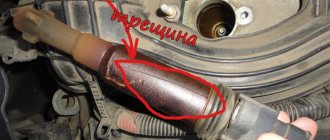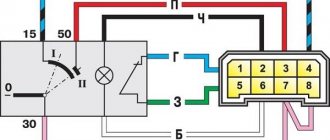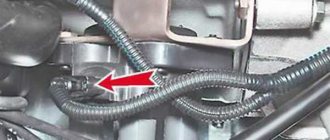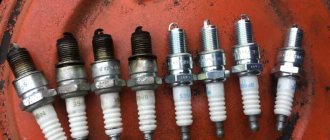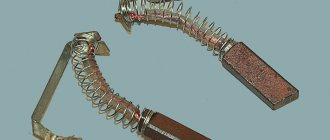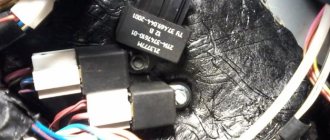Under the term ignition coil breakdown or spark plug tip is understood as a breakdown in the weakest point of the body or wire insulation due to a decrease in resistance, occurring in short periods of time. This is mechanical damage that leads to the appearance of cracks or melting. On the surface of the case, the breakdown site appears as black, burnt-out dots, longitudinal tracks or white cracks. Such spark piercing areas are especially dangerous in humid weather. This malfunction leads not only to failure of the mixture to ignite, but also to complete failure of the ignition module.
Often such places are not difficult to notice visually, but sometimes it is necessary to check the ignition coil, not with a multimeter or oscilloscope, but with a simple device made of two wires. When a damaged area is identified, the part is usually completely replaced, although sometimes it is possible to delay the replacement using electrical tape, sealant or epoxy glue.
Causes of malfunction
Why is there no current or voltage flowing to the output of the coil? How can you determine that the device is faulty? First, let's look at the causes of the malfunctions. Usually this device is a part with a long service life, but of course, there is always the possibility of breakdowns. With regular use of the mechanism and constant current and voltage passing through it, the devices not only heat up, but sometimes even burn.
If repairing the ignition coil does not produce results and the device simply burns out, then this is most likely caused by a short circuit in the system. It is possible to solve the problem if the temperature during its operation is less than 150 degrees, but if it is higher, then the coils burn irrevocably (the author of the video is Useful China).
One of the main causes of a malfunction is problems with power, current and voltage that come from the on-board network. Due to constant changes, the device will work unstably. The voltage level, for example, should be at least 11.5 volts. If the battery is used for a long time, this may cause the voltage level to decrease as the battery's performance decreases.
In addition, the reason that the coils heat up, burn and fail can be a faulty ignition system wire. The problem is solved by replacing the cable. As practice shows, breakdowns in insulation are often the cause of device failures - for example, motor fluid or washer fluid can get through a breakdown. If there really are breakdowns in the insulation, then problems may appear in rainy weather.
As for individual devices, it must be remembered that they always operate under critical temperature conditions. As a result, they heat up and burn no less often, since their service life is actually not particularly long. As practice shows, if such a coil burns out, then trying to repair it with your own hands will be pointless. Certain types of individual devices are susceptible to breakdowns due to high vibrations from the cylinder head.
Ignition coil device
Separately, spark plugs should be highlighted as one of the reasons why there is no spark from the ignition coil. In particular, we are talking about low-quality candles. Cheap fakes cause weak coils to heat up and burn over time. In this case, the reasons are reverse gases, as well as breakdowns in the insulator, which negatively affect the condition of the rubberized tip of the device.
To prevent coil failures, change spark plugs on time!
Symptom 6: Difficulty starting the engine
When the spark plugs are working correctly, starting the engine is quite easy. But when the ignition coil doesn't supply the correct current to the spark plug, starting your engine can be a disaster. The starter may take much longer to spin, and then the engine will show an unstable RPM after it finally starts. The computer engine management system will try to compensate for poor ignition coil performance and change the way fuel and air are supplied to the combustion chambers. But this won't help much with a broken coil.
Signs of breakdown
Below we will consider the main signs and symptoms of malfunctions, as a result of which the coils heat up due to the passage of current and voltage through them, burn and burn out:
- From time to time the engine starts to misfire, if the problem is not solved, failures appear more often. Sometimes dips can appear at certain speeds.
- Another sign is that when the driver presses the gas pedal sharply, a loss of power may be felt.
- If there is no pulse, another symptom of a malfunction will be signals from the on-board computer. If the Check Engine light comes on on the dashboard, you should perform a more thorough diagnosis of the car yourself.
- The device itself gets quite hot.
- If you start the engine in cold weather, the unit will start to stall when you try to start it. These triplets are especially pronounced in rainy weather.
- At some point, if the device stops receiving impulses in the form of current or voltage and the weak coil simply burns, it will be impossible to start the engine at all (video author - vassilij pavliuk).
Symptom 7: Check-engine
If the Check Engine light is on, the problem may be with the ignition coil. There are several sensors that trigger the Check Engine light. For example, the catalytic converter may start to sound an alarm because there are too many emissions. Also, engine sensors may register problems with one of the cylinders.
Test your device yourself
How to fix a weak mechanism with your own hands if there is no current or voltage flowing to it, or another malfunction has occurred with the coil? First of all, you need to make a diagnosis yourself.
There are several checking options:
- The easiest option for diagnosing it yourself is to try disconnecting the connectors from the mechanism one by one at the moment when the engine starts to shake. By disconnecting the connectors from the functioning mechanism, you will be able to hear how dips in speed appear, and some cylinders begin to operate unstably. If, when you disconnect it from a non-working engine with your own hands, the operation of the internal combustion engine does not change, then this weak element needs to be repaired.
- If it is possible to dismantle a weak device, you can try to measure the resistance level on the windings. Measurements are taken directly between the contacts, as well as between the contacts and the spark plug connector. The resistance level on the primary winding should be about 6-8 kOhm, sometimes this figure can increase to 15 thousand Ohms, this is an exception. As for the resistance of the secondary winding, this indicator varies around 0.4-2 Ohms. As practice shows, for faulty mechanisms such indicators will vary greatly.
- Sometimes you can identify the malfunction of a weak coil by self-diagnosis of the car. In some cases, the error code may indicate a specific cylinder that is not working.
Ignition coil repair
In most cases, repairing the coil is not an option; usually the solution to the problem comes down to replacing the mechanism. When replacing, you should check the conformity of the replaced components; they must be completely identical. Before replacing the mechanism, it is necessary to effectively clean all joints from dirt and oil deposits. It would be a good idea to pay attention to the presence of rust - since corrosion increases the resistance value and is often the cause of poor contacts, it should be removed.
If you do not want to encounter breakdowns in the system in the future, then it is advisable to apply dielectric grease to the contacts; instructions may vary depending on the car model.
- The battery is disconnected, from the failed coil you need to disconnect the wiring that goes to the center of the distributor cover.
- Using wrenches, unscrew the nuts that secure the wires on top of the mechanism. If there is corrosion on them, the wires need to be treated with WD-40 and wait a little. The position of the wires must be marked.
- The device itself is held on the body with nuts that need to be loosened, but not completely unscrewed.
- Then the element is moved to the side and dismantled, and a new coil is installed. Further assembly is carried out in reverse order.
Three diagnostic methods
Next, consider three proven methods for checking the ignition coil.
Visual testing method
The strength of the visual testing method (known as the “spark test”) is its ease of implementation. It does not require any equipment and can be performed even on the road. The main disadvantages are reasonably considered to be low accuracy, high labor intensity, and the risk of electric shock.
This method will require a working spark plug and pliers, and you may need a socket wrench.
It is advisable to start work no earlier than a quarter of an hour after turning off the engine, so that it has time to cool down.
First, the wire of the first spark plug is removed and the control spark plug is connected to it. Holding the spark plug by the insulator with pliers, we touch the threaded part of the skirt to the uninsulated metal section of the engine housing. When the engine is running and the coil is working properly, an intense purple spark jumps between the electrode and the housing. To minimize risks, you can not start the engine, but turn on the starter for a couple of seconds.
The conclusion that the coil is faulty is made if the spark is weak or has a pronounced yellowish tint. The absence of a spark indicates a coil failure or a complete lack of contact.
If the engine has several coils, the control procedure is performed for each of them.
If there is no spare working spark plug, a spark plug that is unscrewed from one of the engine cylinders is used as a visual indicator.
A voltage of several kilovolts is applied to the spark plugs. Taking this feature into account, when using the visual inspection method in any form of its implementation, be careful and do not touch unprotected parts of your body to uninsulated parts of the on-board electrical wiring.
Second
This method of identifying problems is similar to the “scientific poking” method. This test of the ignition coil involves disconnecting the terminals one by one while the engine is running. Although this method may seem barbaric to many, it helps to quickly identify a faulty coil.
By disconnecting the wire from the coil, the discharge will stop flowing into the fuel combustion chamber and engine operation in this cylinder will be disrupted. A failure can be easily determined by the sound and rhythm of the motor. If there is no change in engine operation when the next coil is turned off, this is a faulty part.
The third is the scientific way
To check the ignition coil, you will need a multimeter. Remove all coils and check the resistance using a tester. The resistance value is affected by corrosion on the contacts, so before checking, clean the elements from dirt, oil residues and other formations that interfere with accurately determining the characteristics of the element.
To measure the resistance on the primary winding, the probes of the device must be installed on both contacts. In this case, the multimeter must be set to 20 ohms.
Depending on the car models and the type of coil, this value can range from 0.4 to 2 ohms.
However, all four coils (assuming your internal combustion engine has 4 cylinders) should have approximately the same resistance.
To measure the secondary winding, connect the first probe of the device to one of the contacts, and the second to the spring that goes to the coil. Since the resistance value on the secondary winding can be from 6 to 10 kOhm, the multimeter flag should be set to 20 kOhm. Thus, you can easily identify the faulty coil and replace it.
It is worth noting that the resource of this element is 60-70 thousand km. According to the experience of many car enthusiasts, original spare parts installed on a car by the manufacturer can withstand more than 100 thousand, so purchase quality parts from reliable suppliers.
Video: How to identify a faulty ignition coil
Video “The process of replacing the coil on a Lada Granta”
Using the example of a Lada Granta car, familiarize yourself with the process of replacing the mechanism (the author of the video is Lada Granta Fan).
A car's ignition coil serves to form a high-voltage discharge between the spark plug electrodes in gasoline engines. It is this discharge that ignites the fuel mixture at the moment when the piston reaches top dead center. Other elements of the ignition system are responsible for the timely occurrence of the spark. Depending on the design of the engine, this is either an ignition distributor (distributor) or a camshaft position sensor. The power of the spark and whether it will jump through at all depends on the coil. Considering the absolute dependence of engine operation on the condition of this part, it is good to know the signs of a faulty ignition coil. Let's look at how it works and how to determine if an ignition coil is faulty, and what tools are available for checking ignition coils with your own hands.
What faults cannot be diagnosed with an ohmmeter?
An ohmmeter can only diagnose an open or short circuit in the winding. An interturn short circuit in a winding will be barely noticeable when measuring resistance due to the small resistance of one turn and, as a consequence, a slight change in the total resistance when a short circuit between turns. An insulation breakdown between the turns of both one and different windings reveals itself only when this place is exposed to high voltage. It cannot be detected at all using a multimeter.
Therefore, if, as a result of checking with a multimeter, it was not possible to identify a defect, you need to resort to another proven method of detecting a faulty unit. You should replace all coils one by one with a known good one.
Why does contamination interfere with sparking?
The ignition coil, like any other transformer, increases the voltage of an electrical pulse, reduces its current. Contamination of the insulators of coils and spark plugs with oil and carbon deposits conducts electric current, and therefore can be represented in the form of a resistance connected in parallel to the spark gap and shunting it. The current flowing through this shunt from dirt and moisture greatly reduces the power of the electrical pulse applied to the spark gap. Therefore, the pulse voltage on the electrodes of the spark plug also drops, and it is not enough for a reliable breakdown of the interelectrode gap. Consequently, the higher the sparking voltage, the lower the pulse current, and the ignition system is more sensitive to various contaminants.
The design of the coil and the reasons for its failure
Car ignition coil device
A car's ignition coil is a transformer with two windings. A low voltage current flows through the primary winding. At the right moment (determined by the camshaft sensor or distributor), a voltage surge occurs in the primary winding, which induces an electromagnetic pulse in the secondary winding, which, transmitted through the wires, causes a spark discharge between the electrodes of the spark plugs. This, of course, is only a schematic description of the process. There are several types of coils:
The principle of operation of all ignition coils is the same, therefore they all have the same malfunctions.
- oil-filled with one high voltage output;
- “dry” with one or more outlets;
- individual, mounted on candles.
Regardless of the type, the principle of their operation is the same, as well as the same reasons for the failure of the ignition coils. The output pulse voltage is 25,000 - 35,000 volts, which is what causes spark breakdowns to ground when the high-voltage elements of the ignition system are not well insulated. The ignition coil winding wires heat up due to electrical resistance. In addition, at low engine speeds, excess current constantly flows through the primary winding, and the ignition coil heats up more. Excess current, however, is compensated by additional resistance (or semiconductor switches), but insufficient quality of the product can also play a role here. Excessive heating of the winding wires leads to burnout of the insulation, which is why the ignition coil burns out. It should also be taken into account that the load on the windings increases even when the parts associated with it are faulty or their operating conditions are violated. For example, increased temperature conditions of engine operation lead to cracking of the insulation of high voltage wires and their tips. Dirt in combination with water has a similar effect, forming channels for the spark to break through to the “ground”.
Short circuit overheating due to:
- Unstable engine operation. The reason why an engine stalls or stalls when cold when starting is usually that one of its cylinders is not working. As a result, the engine begins to overheat, which leads to overheating of the short circuit, and they fail faster. On the other hand, one of the engine cylinders may not work as a result of a malfunction of the corresponding short circuit.
- Engine overheating due to a lean air-fuel mixture, faulty cooling system, etc.
- Short circuit. This may be a consequence of a violation of the insulation of the coil windings. If the short circuit begins to heat up immediately after turning on the ignition, its urgent replacement is necessary to avoid short-circuiting the entire system. But, if the coil heats up even when the engine is not running, and in addition there is a smell of burnt insulation, then the cause may not be in the coil, but in one of the circuit elements.
Signs of ignition coil failure when it is broken
Contactless ignition system diagram
If the insulation of the coil body is broken, then the spark discharge will follow the path of least resistance - that is, the current intended to ignite the fuel mixture in the cylinder will go to the nearest metal part connected to the “ground” of the car. The engine will react to misfires as follows:
A significant disadvantage of individual ignition coils is their operation in more unfavorable conditions.
- will be unstable at idle;
- the movement of the car will be accompanied by jerks;
- it will be difficult to start;
- failures will appear during acceleration;
- Possible pops in the exhaust and intake systems.
Checking the functionality of the ignition coils
Checking the voltage on the ignition coil windings
As a rule, if the engine stalls on the way and refuses to start, then the serviceability of the ignition is checked by placing the threaded part of the spark plug so that it is in reliable contact with the ground. Cranking the engine with the starter, see if a spark jumps between the electrodes. But this method does not indicate the exact cause of the malfunction - after all, the absence of a spark, in addition to coil failure, can be caused by:
The most accessible device for checking the ignition coil with your own hands is a multimeter turned on in ohmmeter mode.
- spark plug malfunction;
- breakage of wires or their contacts;
- failure of the camshaft or crankshaft sensors;
- breakdown of the ignition distributor (not available on injection cars).
In addition, the fault may lie in the engine ECU. The most accessible device for checking the ignition coil with your own hands is a multimeter turned on in ohmmeter mode. It measures the resistance of the ignition coil, or rather, its primary and secondary windings. The primary winding has a small number of turns, and it is made of large cross-section wire. Therefore, its resistance is low - from 0.4 to 7 Ohms. It is measured between the coil terminals to which the low voltage wires are connected.
The secondary winding is wound with a large number of turns of thin wire and, therefore, has a higher resistance than the primary winding. For different coils it has different values - 5000 to 18,000 Ohms, this depends on the characteristics of the ignition system circuits. For individual coils it is 100,000 - 500,000 Ohms. This spread of values is due to the fact that the contact method of circuit interruption allows the circuit to close and open the power wire of the primary winding at voltage and current values equal to the parameters of the vehicle’s on-board network. The non-contact method of pulse formation occurs at significantly lower values, therefore the secondary windings of the coils have a larger number of turns (and greater resistance) to provide the proper discharge energy. These winding resistance values are approximate only. It is best to find out their exact values given in the description of the electrical equipment of a specific machine model.
High voltage spark gap for testing ignition coil
You can visually check the voltage leak in the ignition system in the dark with the engine running.
In addition, you need to know the ignition circuit diagram. Many coils have a built-in additional resistance (resistor) and by taking measurements blindly, you can measure the resistance of the primary winding in series with the resistor.
Ignition coils and modules can be checked using a spark gap that simulates the operation of the ignition system. This method is good if the distance between the electrodes of the spark gap is chosen correctly - taking into account the fact that when the engine is running, the spark in the spark plug jumps at high pressure and in the air-fuel mixture. You can visually check for voltage leaks and breakdowns in the ignition system; just open the hood in the dark while the engine is running. If there are no light sources nearby, then all spark breakdowns to ground are very clearly visible. This method is good for preventing larger breakdowns - often you only need to change the high-voltage wires.
In conclusion, we can say that the service life of the ignition coil is affected only by the conditions in which it is operated. Change spark plugs and wires on time, do not allow the engine compartment to flood with water, monitor the condition of the electrical equipment - and, quite possibly, you will never have to change the coil.
As you know, an engine requires two conditions to operate: a combustible mixture and a spark. The exception is diesel engines. In them, ignition occurs due to high air compression. However, in cars with a gasoline engine, of which the majority are on the road, the ignition coil often fails. Signs of a malfunction may vary. Well, let's pay closer attention to this mechanism.
How it works
The ignition coil acts as a flyback transformer. Its functionality is to convert low voltage coming from a battery or generator into high voltage.
Structurally, the device consists of two coils and an iron core. The coil is a winding of copper wire. Both coils are nested inside each other, with an iron core inside. One coil is called the primary and has relatively few turns. When the ignition is turned on, the voltage is 12 volts, which corresponds to the voltage of the vehicle's on-board network. Current passes through the coil, creating a magnetic field. To start a spark, the following happens: the current is abruptly turned off, which causes the destruction of the magnetic field. This causes tension in the second, or secondary, bobbin. It has a significantly higher number of turns than the primary, and the voltage ranges from 15,000 to 30,000 volts.
A mechanical contact, an interrupt contact, was initially responsible for turning the primary current on and off. Its setup was complex; it was necessary to find the optimal distance to the contact so that the time for creating the magnetic field - and therefore the ignition time - was not too short. In addition, the service life of such a contact was relatively short - no more than 15,000 kilometers.
Beginning in the mid-1970s, manufacturers began to use electronics. In the mid-1980s, engineers linked the igniter to the injection system and controlled the process digitally. However, microelectronics only work with small currents, and the ignition coil needs 5 amperes. Thus a new component appeared: the power amplifier. It functions much like an amplifier in a stereo system.
A few years later, the ignition distributor became redundant, and each spark plug received its own ignition coil. This had a number of advantages. The ignition voltage is generated where it is needed, there is no high voltage cable. In addition, the charging time increased and, despite the smaller size, the spark was stronger. These single ignition coils usually also include a power amplifier. For three or four cylinder engines they are often combined into one housing, otherwise they are mounted separately above the spark plug.
Signs of a faulty ignition coil
- Unstable engine operation. Popularly this is called tripling. This word appeared back in the days of the USSR, when one of the cylinders on the Soviet “classics” did not work. And as you know, all VAZ engines had four cylinders. Accordingly, the phenomenon when one of them does not work is called tripling. In this case, characteristic vibrations may occur. The motorist will also hear uneven operation of the engine - as if something is missing. This is understandable, because one of the cylinders is idling, that is, the combustible mixture in it does not ignite.
- “Tripling” motor. If one or more cylinders in the engine do not work, acceleration failures are possible. The car will twitch and vibrate. The car also picks up speed very slowly.
- Yellow lamp "Check Engine". Warning lights on the instrument panel may well be a sign of a faulty ignition coil. It is worth noting that this error is not necessarily related to this malfunction. The lamp only indicates general problems with the engine. If “Check Engine” lights up on the instrument panel, this means that a failure has occurred in some system. The car is subject to thorough diagnostics.
- High fuel consumption. Since one cylinder is not working, the remaining three (or more depending on the engine design) take on the entire load. Accordingly, in order to resume the previous power, the motor will require more energy. Fuel consumption can increase by 10 to 50 percent.
- Difficulty starting the engine. If there is a malfunction with the coil, the driver may experience problems of this kind. Moreover, they occur both when the engine is cold and when the engine is warm. Difficulty starting the engine is especially common in wet weather.
Symptom 5: Increased emissions
The problem of fuel not burning properly creates another problem: higher emissions. If the fuel is burned, the remaining products pass through the catalytic converter and exhaust gas recirculation system to reduce the amount of materials released into the atmosphere. But clean fuel cannot be neutralized using these tools, so it is sent directly into the air or burned in the exhaust pipe. You may not be able to see this symptom, but modern cars will signal that something is wrong with the catalytic converter.
Insulation breakdown
Just like with candles, a breakdown in the insulation can occur here. What could be causing this? Often a breakdown occurs due to oil leaks that form at the junction of the valve cover, head and other elements. As the rpm increases, the oil pressure increases. Oil begins to get on all elements, including the ignition coil. Signs of malfunction: failures in acceleration, jerking and high fuel consumption. To prevent this, keep the engine compartment clean.
Please note that an insulation breakdown may also occur due to engine washing. Excess moisture gets onto the contacts, causing a short circuit. To prevent this, you should cover not only the battery, but also the coil itself. It is also recommended to insulate the distributor cap if it is an older car. By the way, a wet distributor is the most popular reason why a car won’t start at all. Sometimes you can limit yourself to drying contacts. But in 80 percent of cases, only replacement saves.
Adviсe
In order for the coil to work longer, follow the rules:
- install the device on standard mounts;
- do not clutter the device area, ensuring good ventilation;
- keep the body clean;
- check spark plugs and high-voltage wires promptly (before the start of each operating season).
1200 rub. for the photo report
We pay for photo reports on car repairs. Earnings from 10,000 rubles/month.
Write:
The term breakdown of an ignition coil or spark plug tip means a breakdown in the weakest point of the housing or wire insulation due to a decrease in resistance, occurring in short periods of time. This is mechanical damage that leads to the appearance of cracks or melting. On the surface of the case, the breakdown site appears as black, burnt-out dots, longitudinal tracks or white cracks. Such spark piercing areas are especially dangerous in humid weather. This malfunction leads not only to failure of the mixture to ignite, but also to complete failure of the ignition module.
Often such places are not difficult to notice visually, but sometimes it is necessary to check the ignition coil, not with a multimeter or oscilloscope, but with a simple device made of two wires. When a damaged area is identified, the part is usually completely replaced, although sometimes it is possible to delay the replacement using electrical tape, sealant or epoxy glue.
Natural wear and tear
The ignition coil is designed for a long service life. There are often cases when an element worked even after a run of 150–200 thousand kilometers without a single replacement. But with every kilometer, the life of the coil decreases. The installation of low-quality spark plugs or careless cleaning of the engine compartment can contribute to the breakdown. At one point, the part may simply not withstand the load.
Ignition coil: prices
The cost of this element varies significantly. So, for domestic Ladas you can find a coil for 600–800 rubles. But for the tenth Lancer, which is so popular in Russia, a new element costs at least 3 thousand rubles. It's cheaper only from a showdown. But here you will not receive any guarantees or information about the residual resource. You can go another way - repair the ignition coil. This will save you a lot of money. But the ignition coil circuit is quite complex. You can only repair cracks with your own hands - seal them with specialized glue.
Can it be repaired?
You can repair the ignition coil yourself. To do this you will need a heat shrink tube with a diameter of 25-30mm, a hair dryer and scissors. The heat shrink is placed on the coil itself and cut off. Next, you should heat it and wait until it tightly grips the short circuit. Many car enthusiasts put another tube on top of the heat shrink to make the fixation tighter.
As a result, it turns out that the coil will no longer be overtaken by a breakdown. If an error occurred on the control panel, the indicator stops blinking. The engine also stops running. But this repair method is not long-term. You should not resort to it for serious reasons. This is only a temporary measure.
As for older coil models, their resistance often burns out. To eliminate the problem, you need to remove the part, remember the location of the wires and rewind the additional resistor. On modern products there is no resistance, but other faults slip through from time to time. For example, mechanical damage, chips of the cover, thread wear or breakdown of the pulse to ground.
A broken cover can be replaced with a new one. After this, performance is restored. As for cracks and chips, they are sealed with epoxy resin. Do-it-yourself repairs are possible, but they won’t last long.


